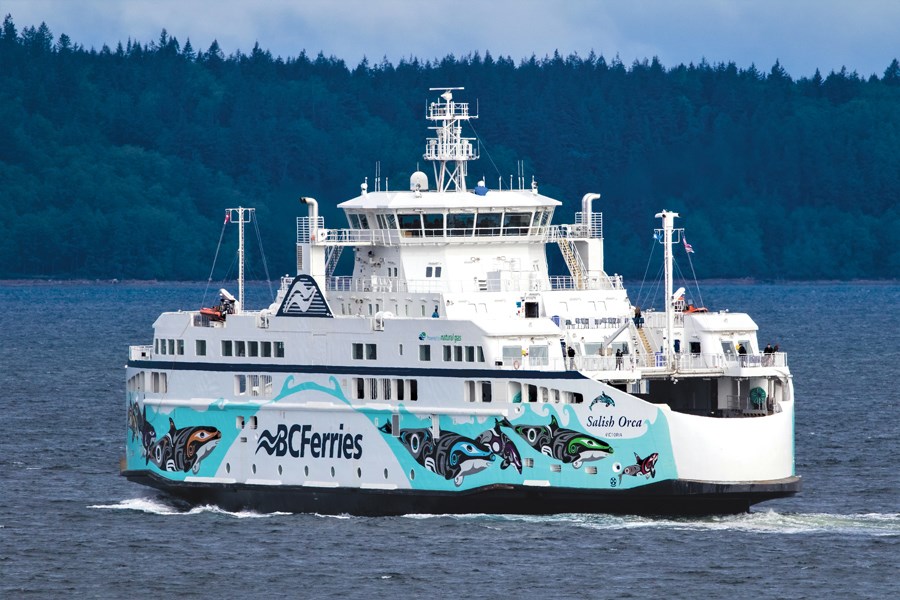Operational issues overshadowed the first week of sailings for BC Ferries’ newest vessel, the Salish Orca. On Monday, May 22, one of the busiest travel days of the summer, ferry customers at Little River and Westview terminals faced lengthy delays as the ship’s computer controls stopped communicating with its propulsion system.
Forced to call in electrical experts to correct the problem, BC Ferries saw the Orca, less than one week into service, experience more than four hours of delay on the Victoria Day holiday, said manager of public affairs Deborah Marshall.
“There are definitely learning curves with new vessels,” said Marshall. “We had engaged and disengaged this electrical breaker probably hundreds of times, but unfortunately we did have an issue that came up. Certainly, our engineers will take this as a learning going forward.”
BC Ferries launched its newest ferry on Tuesday, May 16, with its inaugural sailing from Comox to Powell River. The new duel-fuel ferry replaced the 52-year-old Queen of Burnaby, which is now retired.
Loading the new vessel in Comox for its first run took longer than scheduled. By the time Salish Orca left Little River Terminal, it was already running about 20 minutes late, which was further compounded upon arrival at Westview Terminal. The first run from Westview departed 46 minutes late.
With the new vessel comes a learning curve for its crew, said BC Ferries CEO and president Mark Collins during its first run.
While standing on the outside deck watching cars load and greeting passengers on its inaugural sailing, Collins said he expected it will take some time before the crew is able to load and unload with the same proficiency it had with Queen of Burnaby. The ship’s crew ran a number of soft sailings to become more accustomed to loading the vessel.
“We’re learning what works and what doesn’t,” said Collins. “That adjustment process will go on for the first year of the ship. The big learnings, we’ll figure that out before peak season.”
The new ferry has a 145-car capacity, 23 fewer than Queen of Burnaby’s 168-car capacity, although the Burnaby’s full capacity was rarely used due to ramps often being unavailable when commercial vehicles were aboard.
Features that stand out on the new ferry include large hatches in the upper car deck that allow access to the lower car deck, a well-lit garage six lanes wide for cars. Commercial vehicles and others that require more height clearance are loaded onto the upper deck.
Collins said the crew will improve its loading speed by having the lower deck hatch raised so vehicles can be loaded on lower and upper decks at the same time.
Collins added that he understands passengers may not perceive the lower deck as an attractive place to park, but said one of the perks of parking there is that the lower decks are the first to unload.
Michael Smit, Salish Orca’s senior master, who spent about seven years on Queen of Burnaby, is one of the new vessel’s five captains. He helped drive the ship from the Canary Islands through the Panama Canal during its 50-day journey from Poland to Canada.
“It was a real pleasure to take it out into the open ocean; a lot of fun,” said Smit. “It’s extremely maneuverable.”
According to Smit, a big difference between Queen of Burnaby and Salish Orca is that the new ferry does not need to be turned around because its bridge has 360-degree visibility and controls on both sides.
Salish Orca’s sharper hull shape tends to cut through swells rather than bouncing over top of them like Queen of Burnaby did, said Smit. It will mean improved heavy-weather performance and a smoother ride for passengers, he added.
Large steel visors on hydraulic lifts at each end protect car decks from sea spray. Salish Orca is faster, too, running at just over 15 knots; Queen Burnaby topped out at between 12 and 13 knots. Running time for the ferry remains 90 minutes in order to maintain the same schedule, however more time can be made up if the vessel is delayed at the dock.
Salish Orca has two elevators, four stairwells, a full galley and washrooms on each deck. “It’s a modern vessel geared to getting mobility-challenged passengers on board,” said Smit. “We have a lot more amenities on board.”
One feature not visible to the travelling public, but significant to the ship, is that it operates on liquified natural gas (LNG) as well as low-sulphur marine diesel.
Collins said using natural gas over diesel can reduce a ship’s operating costs by up to 40 per cent.
“There’s no other technology in the marine world that will save you that kind of money,” he said.
BC Ferries estimates that running the ship on LNG will reduce carbon emissions roughly the equivalent to taking 1,900 cars off the road annually.
Collins acknowledged that BC Ferries has taken a considerable risk building a passenger and vehicle ferry fuelled by LNG, one of the first in Canada, but said everything has gone smoothly with it so far.
“The LNG,” he said, “has been extraordinary.”



